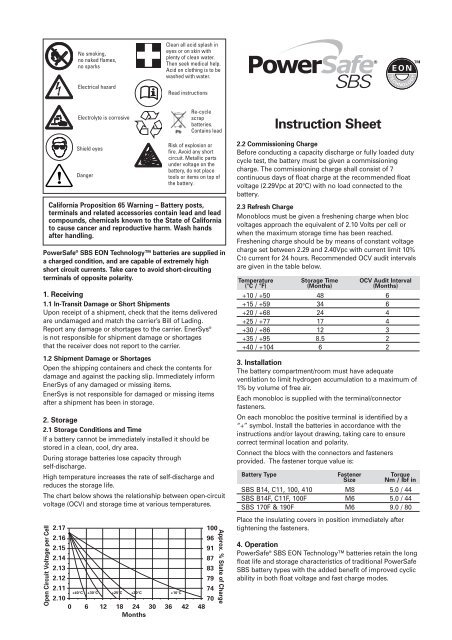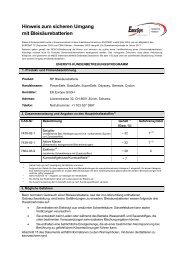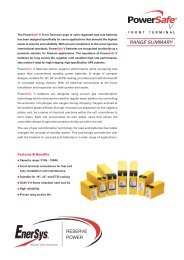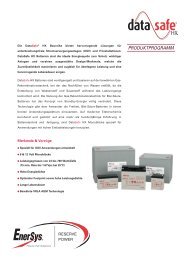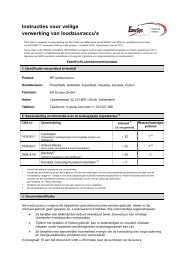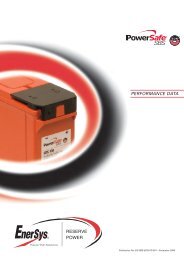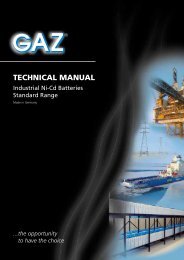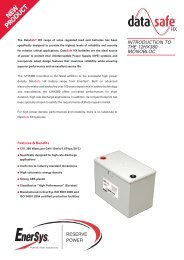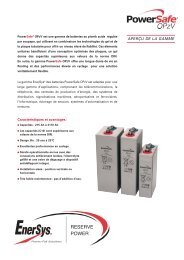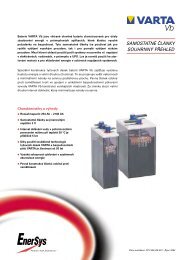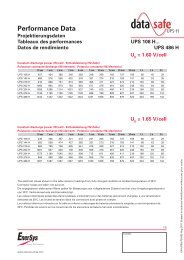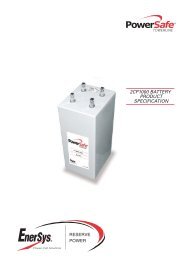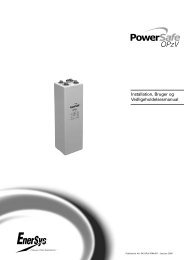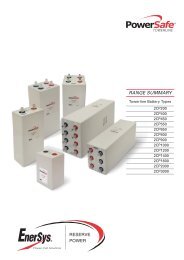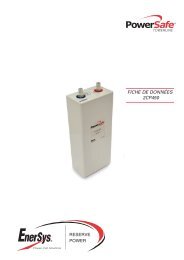Instruction Sheet - Enersys - EMEA
Instruction Sheet - Enersys - EMEA
Instruction Sheet - Enersys - EMEA
You also want an ePaper? Increase the reach of your titles
YUMPU automatically turns print PDFs into web optimized ePapers that Google loves.
PowerSafe ® SBS EON Technology batteries are supplied in<br />
a charged condition, and are capable of extremely high<br />
short circuit currents. Take care to avoid short-circuiting<br />
terminals of opposite polarity.<br />
1. Receiving<br />
1.1 In-Transit Damage or Short Shipments<br />
Upon receipt of a shipment, check that the items delivered<br />
are undamaged and match the carrier’s Bill of Lading.<br />
Report any damage or shortages to the carrier. EnerSys ®<br />
is not responsible for shipment damage or shortages<br />
that the receiver does not report to the carrier.<br />
1.2 Shipment Damage or Shortages<br />
Open the shipping containers and check the contents for<br />
damage and against the packing slip. Immediately inform<br />
EnerSys of any damaged or missing items.<br />
EnerSys is not responsible for damaged or missing items<br />
after a shipment has been in storage.<br />
2. Storage<br />
2.1 Storage Conditions and Time<br />
If a battery cannot be immediately installed it should be<br />
stored in a clean, cool, dry area.<br />
During storage batteries lose capacity through<br />
self-discharge.<br />
High temperature increases the rate of self-discharge and<br />
reduces the storage life.<br />
The chart below shows the relationship between open-circuit<br />
voltage (OCV) and storage time at various temperatures.<br />
Open Circuit Voltage per Cell<br />
No smoking,<br />
no naked flames,<br />
no sparks<br />
Electrical hazard<br />
Electrolyte is corrosive<br />
Shield eyes<br />
Danger<br />
Clean all acid splash in<br />
eyes or on skin with<br />
plenty of clean water.<br />
Then seek medical help.<br />
Acid on clothing is to be<br />
washed with water.<br />
Read instructions<br />
Re-cycle<br />
scrap<br />
batteries.<br />
Contains lead<br />
Risk of explosion or<br />
fire. Avoid any short<br />
circuit. Metallic parts<br />
under voltage on the<br />
battery, do not place<br />
tools or items on top of<br />
the battery.<br />
California Proposition 65 Warning – Battery posts,<br />
terminals and related accessories contain lead and lead<br />
compounds, chemicals known to the State of California<br />
to cause cancer and reproductive harm. Wash hands<br />
after handling.<br />
2.17<br />
100<br />
2.16<br />
96<br />
2.15<br />
91<br />
2.14<br />
87<br />
2.13<br />
83<br />
2.12<br />
79<br />
2.11<br />
2.10<br />
+40°C +30°C +25°C +20°C +10°C<br />
74<br />
70<br />
0 6 12 18 24 30 36 42 48<br />
Months<br />
Approx. % State of Charge<br />
<strong>Instruction</strong> <strong>Sheet</strong><br />
2.2 Commissioning Charge<br />
Before conducting a capacity discharge or fully loaded duty<br />
cycle test, the battery must be given a commissioning<br />
charge. The commissioning charge shall consist of 7<br />
continuous days of float charge at the recommended float<br />
voltage (2.29Vpc at 20°C) with no load connected to the<br />
battery.<br />
2.3 Refresh Charge<br />
Monoblocs must be given a freshening charge when bloc<br />
voltages approach the equivalent of 2.10 Volts per cell or<br />
when the maximum storage time has been reached.<br />
Freshening charge should be by means of constant voltage<br />
charge set between 2.29 and 2.40Vpc with current limit 10%<br />
C10 current for 24 hours. Recommended OCV audit intervals<br />
are given in the table below.<br />
Temperature Storage Time OCV Audit Interval<br />
(°C / °F) (Months) (Months)<br />
+10 / +50 48 6<br />
+15 / +59 34 6<br />
+20 / +68 24 4<br />
+25 / +77 17 4<br />
+30 / +86 12 3<br />
+35 / +95 8.5 2<br />
+40 / +104 6 2<br />
3. Installation<br />
The battery compartment/room must have adequate<br />
ventilation to limit hydrogen accumulation to a maximum of<br />
1% by volume of free air.<br />
Each monobloc is supplied with the terminal/connector<br />
fasteners.<br />
On each monobloc the positive terminal is identified by a<br />
“+” symbol. Install the batteries in accordance with the<br />
instructions and/or layout drawing, taking care to ensure<br />
correct terminal location and polarity.<br />
Connect the blocs with the connectors and fasteners<br />
provided. The fastener torque value is:<br />
Battery Type Fastener<br />
Size<br />
Torque<br />
Nm / lbf in<br />
SBS B14, C11, 100, 410 M8 5.0 / 44<br />
SBS B14F, C11F, 100F M6 5.0 / 44<br />
SBS 170F & 190F M6 9.0 / 80<br />
Place the insulating covers in position immediately after<br />
tightening the fasteners.<br />
4. Operation<br />
PowerSafe ® SBS EON Technology batteries retain the long<br />
float life and storage characteristics of traditional PowerSafe<br />
SBS battery types with the added benefit of improved cyclic<br />
ability in both float voltage and fast charge modes.
4.1 Interchangeability<br />
PowerSafe ® SBS EON Technology battery types are fully<br />
interchangeable with standard PowerSafe SBS battery<br />
equivalents (where applicable). When used in conventional<br />
float applications the fit, form and function remain unchanged<br />
and their mixing will have no detrimental effect to either the<br />
performance or expected service life. However, where a<br />
PowerSafe SBS EON Technology monobloc is introduced as a<br />
replacement into an equivalent standard PowerSafe SBS<br />
battery, it must be understood that the improved cyclic<br />
capability afforded by EON Technology will not be achieved.<br />
4.2 Stand by / Float Operation<br />
Constant voltage chargers are recommended. The charging<br />
voltage should be set at the equivalent of 2.29Vpc at 20°C/68°F<br />
or 2.27Vpc at 25°C/77°F.<br />
Operation at temperatures higher than 20°C will reduce life<br />
expectancy. Life is reduced by typically 50% for every 10°C rise<br />
in temperature. To offset the impact of higher temperatures<br />
compensation to the float voltage should be applied.<br />
The recommended float voltage temperature compensation is:<br />
Temperature (°C / °F)<br />
10/50 15/59 20/68 25/77 30/86 35/95 40/104<br />
Recommended 2.33 2.31 2.29 2.27 2.25 2.23 2.21<br />
Minimum 2.31 2.29 2.27 2.25 2.23 2.21 2.21<br />
In float applications where recharge time to repeat duty<br />
is not critical, the rectifier current can be limited to load<br />
+ 10% C10 Amps.<br />
4.3 Cyclic Operation<br />
In addition to the long life characteristics inherent in traditional<br />
TPPL designs, EON Technology has been developed to<br />
provide high performance in applications where the battery is<br />
subjected to repeated cyclic duty or where power reliability is<br />
tested by high temperatures and harsh conditions combined<br />
with remote locations.<br />
In cyclic applications the charging voltage should be set at the<br />
equivalent of 2.40Vpc cell at 20°C/68°F, with the rectifier<br />
current limit set to a minimum of 10% C10 Amps (EON<br />
Technology is designed to accept in rush currents up to 6C10<br />
Amps without causing damage to the internal<br />
electrochemistry).<br />
In cyclic applications, optimal life and performance is obtained<br />
by limiting recharge @ 2.40Vpc to the time taken to return<br />
103% of discharged Ah before disconnecting the battery from<br />
the rectifier or switching to float voltage.<br />
In systems where control of charge factor is not possible,<br />
7. Connectors<br />
Battery<br />
Type<br />
Connector<br />
Part No.<br />
SBS B14, C11 2205-8919<br />
SBS B14F, C11F 2205-8891<br />
SBS 100 2205-8750<br />
SBS 100F 2205-8749<br />
SBS 170F & 190F 2205-8769<br />
SBS 410 2205-9887 (A)<br />
SBS 410 2205-8865 (B)<br />
www.enersys-emea.com<br />
EnerSys<br />
P.O. Box 14145<br />
Reading, PA 19612-4145<br />
USA<br />
Tel: +1-610-208-1991<br />
+1-800-538-3627<br />
Fax: +1-610-372-8613<br />
EnerSys Europe<br />
Zurich, Switzerland<br />
EnerSys Asia<br />
Guangdong, China<br />
Tel: +86-755-2689 3639<br />
the battery will be returned to full state of charge (from 100%<br />
depth of discharge C10) in 6.5 hours at 2.40Vpc with 0.25C10<br />
Amps available. Higher charge currents will reduce charge<br />
time, lower currents will increase charge time.<br />
The recommended compensation for charge voltage in cyclic<br />
applications is:<br />
Temperature (°C / °F)<br />
10/50 15/59 20/68 25/77 30/86 35/95 40/104<br />
Vpc 2.44 2.42 2.40 2.38 2.36 2.34 2.32<br />
Warning: Continuous charge at 2.40Vpc will significantly<br />
reduce battery life.<br />
For additional information on the operation of PowerSafe<br />
SBS EON Technology batteries please refer to the application<br />
guide.<br />
5. Maintenance<br />
In practice, the user usually specifies the maintenance<br />
schedule based on site criticality, location and manpower.<br />
The following is a suggested maintenance schedule.<br />
• Monthly (record all readings)<br />
Measure the battery string voltage. If necessary, adjust the<br />
float voltage to the correct value.<br />
• Every six months (record all readings)<br />
Measure the battery string voltage. If necessary, adjust the<br />
float voltage to the correct value.<br />
Measure individual bloc voltages. The blocs should be<br />
within 5% of the average.<br />
Inspect for contamination by dust, loose or corroded<br />
connections. If necessary isolate the string/bloc and clean<br />
with a damp soft cloth. Warning - Do NOT use any type of<br />
oil, solvent, detergent, petroleum-based solvent or<br />
ammonia solution to clean the battery containers or lids.<br />
These materials will cause permanent damage to the<br />
battery container and lid and will invalidate the warranty.<br />
Contact EnerSys ® if you have any questions regarding<br />
maintenance.<br />
6. Disposal<br />
PowerSafe SBS EON Technology batteries are recyclable.<br />
Scrap batteries must be packaged and transported in<br />
accordance with prevailing transportation rules and<br />
regulations.<br />
Scrap batteries must be disposed of in compliance with<br />
local and national laws by a licensed or certified lead acid<br />
battery recycler.<br />
SBS B14, C11, 100 SBS B14F, C11F, 100F,<br />
170F, 190F<br />
EnerSys Ltd.<br />
Rake Lane,<br />
Clifton Junction,<br />
Swinton, Manchester<br />
M27 8LR, UK<br />
Tel: +44 (0)161 794 4611<br />
Fax: +44 (0)161 727 3809<br />
A<br />
Contact:<br />
SBS 410<br />
© 2009 EnerSys. All rights reserved.<br />
Trademarks and logos are the property of<br />
EnerSys and its affiliates unless otherwise noted.<br />
B<br />
Publication No. EN-SBS-EON-IS-004 - December 2009 - Subject to revisions without prior notice. E.&O.E.


